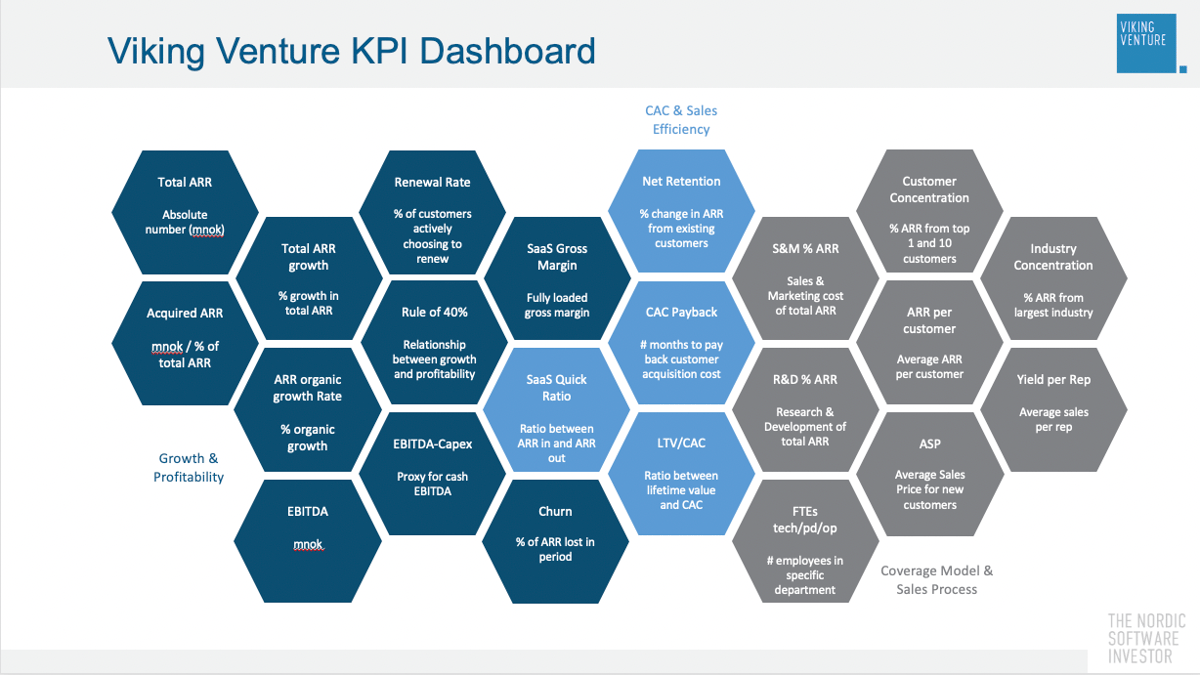SaaS KPIs
Welcome to the world of Revenue Operations (RevOps), where data-driven decision-making reigns supreme. As a seasoned RevOps professional, I understand the vital role that Key Performance Indicators (KPIs) play in optimising revenue generation processes. In this comprehensive document, I've gathered a wealth of KPIs, along with their concise definitions, carefully curated from my years of experience. Whether you're a fellow RevOps enthusiast, a sales leader, or a revenue-focused executive, this resource is designed to be your go-to reference for unlocking the power of data in achieving revenue excellence. Dive in, explore, and harness the insights within to drive your organisations success to new heights
All (or most) of the KPIs you will ever need..

1. Monthly Recurring Revenue (MRR): The predictable and recurring revenue generated from subscription-based customers on a monthly basis
2. Annual Recurring Revenue (ARR): The predictable and recurring revenue generated from subscription-based customers on an annual basis
3. Churn Rate: The percentage of customers who cancel or do not renew their subscriptions within a specific time period. Calculated as (Number of Churned Customers / Total Customers at the Beginning of the Period) × 100
4. Customer Lifetime Value (CLTV): The average total revenue generated from a customer during their entire relationship with the company, accounting for subscription duration and associated costs.
5. Customer Acquisition Cost (CAC): The average cost incurred to acquire a new customer. Calculated as (Total Sales and Marketing Expenses / Number of New Customers Acquired).
6. CAC Payback Period: The time it takes for the company to recoup the CAC through the revenue generated from a new customer. This helps assess the efficiency of customer acquisition.
7. Gross Margin: The percentage of revenue that remains after deducting the cost of goods sold (COGS). Calculated as ((Revenue - COGS) / Revenue) × 100.
8. Net Promoter Score (NPS): A customer satisfaction metric that measures the likelihood of customers to recommend the company's product/service to others.
9. Customer Satisfaction (CSAT): A metric that gauges customer satisfaction with the product or service, often measured through surveys and feedback.
10. Active Users/Customers: The number of users or customers actively engaging with the product/service within a given time period.
11. Usage Metrics: Depending on the nature of the SaaS product, these could include metrics such as the number of logins, features used, data uploaded, etc.
12. Customer Retention Rate: The percentage of customers who continue using the product/service over a specific time period. Calculated as ((Customers at the End of the Period - New Customers) / Customers at the Start of the Period) × 100.
13. Upsell/Cross-sell Rate: The percentage of existing customers who upgrade to higher-tier plans or purchase additional features/products.
14. Lead-to-Customer Conversion Rate: The percentage of leads that convert into paying customers. Calculated as (Number of New Customers / Number of Leads) × 100.
15. Average Revenue per User (ARPU): The average revenue generated from each user/customer. Calculated as (Total Revenue / Total Number of Users/Customers).
16. Average Selling Price (ASP): The average price at which the product/service is sold.
17. Sales Pipeline Value: The total value of potential deals currently in the sales pipeline.
18. Sales Conversion Rate: The percentage of leads or opportunities that are successfully converted into paying customers.
19. Time to First Value: The time it takes for a customer to realize the initial value of the product after onboarding.
20. Employee Satisfaction: Internal KPI that measures the satisfaction and engagement of company employees. Often measured through surveys and feedback
21. Operational Efficiency Metrics: These could include metrics related to product development cycle, bug resolution time, customer support response time, etc.
22. Average Contract Length (ACL): The average duration of customer contracts. This metric can provide insights into customer commitment and potential revenue stability.
23. Renewal Rate: The percentage of customers who renew their subscriptions. Calculated as (Number of Renewed Customers / Total Customers Eligible for Renewal) × 100.
24. Expansion Revenue: The additional revenue generated from existing customers who upgrade their plans or purchase additional products/features.
25. Customer Engagement: Measured through metrics like frequency of product usage, feature adoption, and interaction with the platform.
26. User Churn Rate: Similar to customer churn rate, but focused on individual users within a customer account.
27. Net Revenue Retention Rate: Measures the change in revenue from existing customers after accounting for expansions, contractions, and churn. A rate above 100% indicates overall growth from existing customers.
28. Customer Acquisition Rate: The rate at which new customers are acquired over a specific time period.
29. Lead Conversion Time: The time it takes for a lead to convert into a paying customer. It helps in understanding the efficiency of the sales process.
30. Product Adoption Rate: Measures how quickly new users or customers adopt and start using the product after signing up.
31. Feature Adoption Rate: Measures the usage of specific features within the product, helping to identify which features are most valuable to customers.
32. Average Response Time: For customer support, this measures the average time taken to respond to customer inquiries or issues.
33. First Response Time: The time taken to provide the first response to a customer inquiry. A crucial metric for customer satisfaction.
34. Customer Support Resolution Rate: The percentage of customer issues or inquiries that are successfully resolved by the support team
35. Website Traffic: The number of visitors to your company website. This could be segmented by source (organic, referral, paid) and location.
36. Conversion Rate: The percentage of website visitors who take a desired action, such as signing up for a trial or subscribing.
37. Lead Velocity Rate: Measures the growth rate of leads in the pipeline, indicating the health of the sales funnel.
38. Referral Rate: The percentage of new customers acquired through referrals from existing customers or partners.
39. Customer Onboarding Completion Rate: Measures the rate at which new customers complete the onboarding process.
40. Product Stickiness: Measures the extent to which customers rely on the product for their daily operations, making it more difficult for them to switch to a competitor.
41. Time on Platform: The average amount of time users spend actively using the platform during a session.
42. Trial-to-Paid Conversion Rate: The percentage of trial users who convert to paid customers.
43. Employee Productivity Metrics: These could include metrics related to development velocity, support ticket resolution per employee, and other department-specific measures.
44. Customer Acquisition Funnel Conversion Rates: Breakdown of conversion rates at each stage of the customer acquisition funnel, from lead generation to conversion.
45. Lead Source Effectiveness: Measures the effectiveness of different lead sources (e.g., organic search, paid ads, referrals) in terms of generating high-quality leads.
46. Sales Cycle Length: The average time it takes for a lead to move through the entire sales process and become a customer.
47. Customer Segmentation Metrics: Analyze performance metrics based on customer segments, such as industry, company size, or geographic location.
48. Active Usage Frequency: Measures how often active users engage with the product within a given time frame (e.g., daily, weekly).
49. Mobile vs. Desktop Usage: Breakdown of product usage across mobile devices and desktop computers.
50. Customer Health Score: An aggregated score that combines various metrics to assess the overall health of customer relationships.
51. Customer Effort Score (CES): Measures the ease of customers' interactions with the product, service, or support
52. Funnel Drop-Off Points: Identify where in the user journey customers are dropping off, helping to pinpoint areas for improvement.
53. Content Engagement Metrics: For content marketing efforts, track metrics such as blog post views, whitepaper downloads, and webinar attendance.
54. Social Media Engagement: Metrics related to likes, shares, comments, and overall engagement on social media platforms.
55. Partnership and Integration Performance: For SaaS companies with partner networks, track metrics related to partner-driven leads, conversions, and joint marketing efforts.
56. Customer Sentiment Analysis: Analyze customer feedback and sentiment through tools like sentiment analysis on support tickets, reviews, and surveys.
57. Subscriber Growth Rate: For email newsletters or updates, measure the rate at which new subscribers are joining.
58. Competitor Benchmarking: Compare your company's performance to that of key competitors in terms of key metrics like market share, growth rate, and customer satisfaction.
59. New Feature Adoption Rate: Track how quickly users adopt and engage with newly released product features.
60. User Feedback Participation Rate: Measure the rate at which users provide feedback or suggestions for product improvement.
61. Cost per Lead by Channel: Calculate how much it costs to generate a lead from different marketing channels.
62. Lead Quality Metrics: Assess lead quality through metrics like lead score, job title, company size, and engagement level.
63. Customer Feedback Response Rate: Track how often your team responds to customer feedback, whether positive or negative.
64. Social Proof Metrics: Monitor metrics like the number of positive reviews, testimonials, and case studies.
65. Trial Engagement Metrics: Measure trial users' engagement with the product during the trial period.
66. Compliance and Security Metrics: For SaaS products handling sensitive data, monitor compliance with industry standards and security protocols.
67. Downtime and Uptime: Measure the percentage of time your product is available for users, aiming for high uptime and minimal downtime.
68. Refund and Cancellation Rate: Monitor the rate at which customers request refunds or cancel their subscriptions.
69. Landing Page Conversion Rates: Measure the effectiveness of landing pages in converting visitors into leads.
70. Employee Training and Development Metrics: Monitor the progress of new employees' training programs and their integration into their roles.







